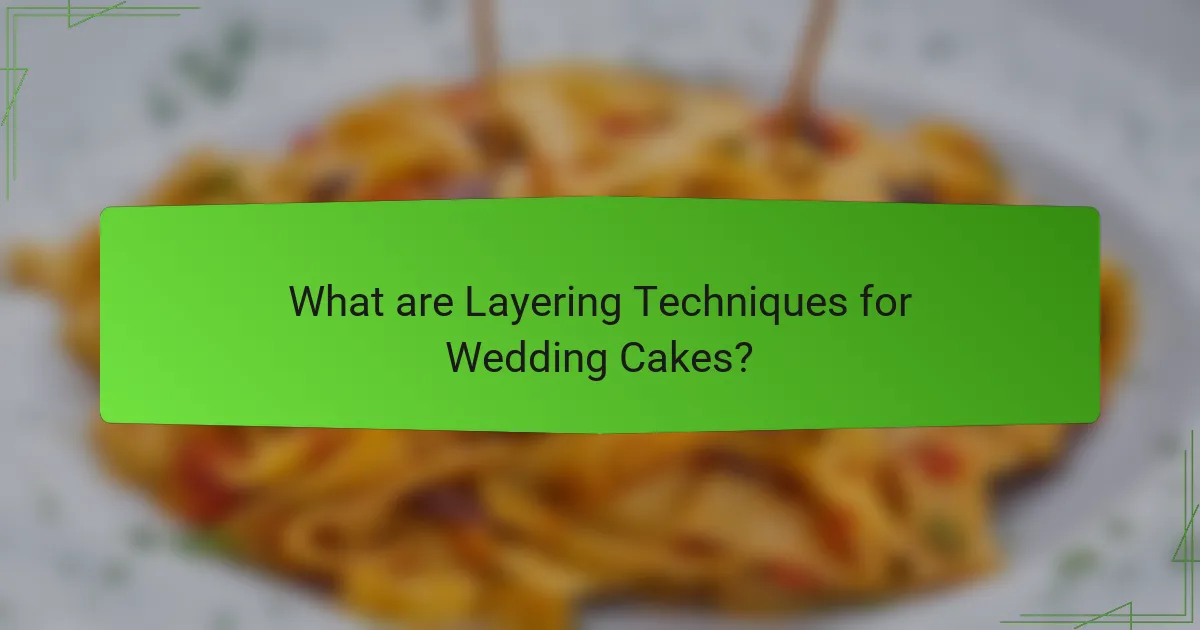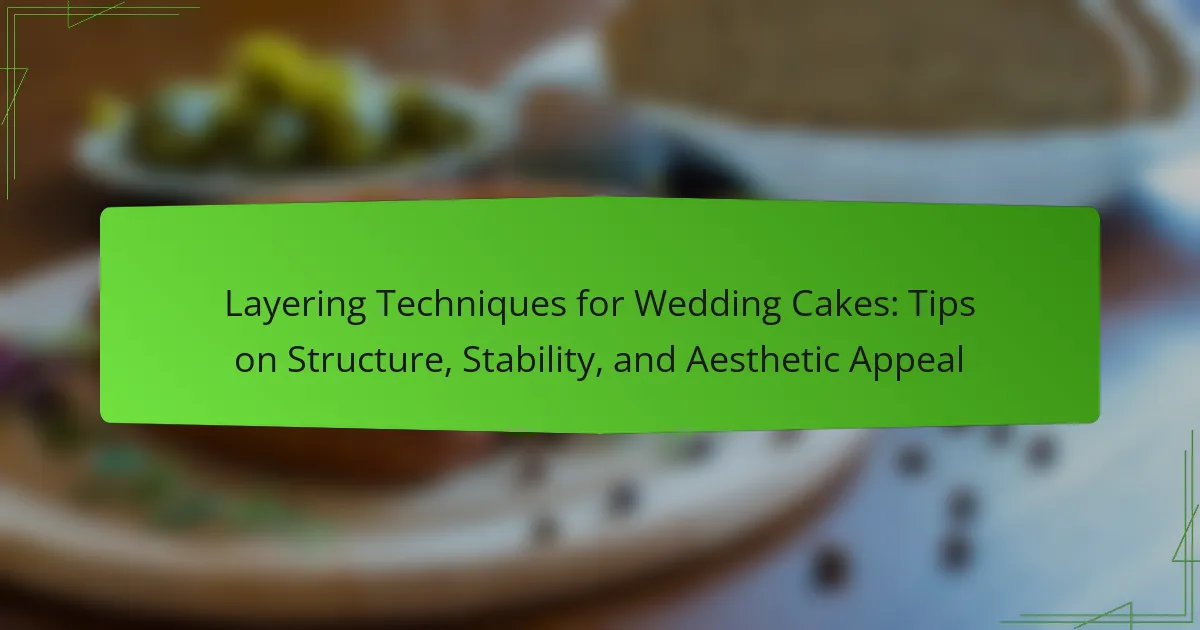
What are Layering Techniques for Wedding Cakes?
Layering techniques for wedding cakes involve stacking multiple cake layers to create height and visual appeal. Common methods include using dowels for support and ensuring even baking for uniform layers. Bakers often use buttercream or fondant between layers for stability and aesthetics. The choice of cake flavors and fillings can enhance the overall design. Proper cooling and leveling of each layer are crucial for stability. Additionally, decorative elements like flowers or ribbons can be added to enhance the cake’s appearance. These techniques are essential for achieving a balanced and beautiful wedding cake.
How do layering techniques impact the overall design of wedding cakes?
Layering techniques significantly enhance the overall design of wedding cakes. They create visual interest and depth through tiered structures. Each layer can showcase different flavors and textures. This variety appeals to diverse guest preferences. Additionally, well-executed layering contributes to the cake’s stability. Proper support systems, like dowels, prevent structural collapse. Aesthetic appeal is heightened by incorporating decorative elements between layers. Techniques such as fondant draping and edible flowers can be utilized. Overall, layering techniques are crucial for both functionality and beauty in wedding cake design.
What are the different types of layers used in wedding cakes?
Wedding cakes typically have three main types of layers: cake layers, filling layers, and frosting layers. Cake layers are the primary structure of the cake, made from various flavors like vanilla, chocolate, or red velvet. Filling layers are placed between the cake layers and can include fruit preserves, custards, or ganache. Frosting layers cover the exterior of the cake, providing decoration and flavor; common types include buttercream, fondant, and cream cheese frosting. Each layer type contributes to the overall taste and stability of the cake. The combination of these layers can create a visually appealing and delicious wedding cake.
How do layer sizes affect the cake’s appearance and stability?
Layer sizes significantly impact a cake’s appearance and stability. Smaller layers create a more delicate look and allow for intricate designs. They also reduce the risk of collapsing under their own weight. Conversely, larger layers provide a more substantial appearance but can lead to structural challenges. A cake with uneven layer sizes may appear unbalanced, affecting its aesthetic appeal. Stability is enhanced when layers are uniform in size, as this distributes weight evenly. Cakes with varying layer sizes require additional support to maintain integrity. Properly sized layers contribute to a visually appealing and stable cake structure.
Why is structure important in wedding cake layering?
Structure is important in wedding cake layering to ensure stability and prevent collapse. Proper layering techniques distribute the weight evenly across the cake. This prevents sagging or tilting, which can ruin the cake’s appearance. Additionally, a well-structured cake can support decorative elements like fondant or flowers. Cakes that lack structure may result in uneven surfaces or even structural failure during transport. Using dowels or supports further enhances stability. Research indicates that cakes with proper internal support maintain their shape better over time. Therefore, structure is essential for both aesthetic appeal and functional integrity.
What materials contribute to the structural integrity of layered cakes?
Flour, eggs, sugar, and butter are primary materials that contribute to the structural integrity of layered cakes. Flour provides the necessary gluten structure, which helps the cake hold its shape. Eggs add moisture and act as a binding agent, enhancing stability. Sugar not only sweetens but also contributes to the cake’s texture and moisture retention. Butter adds richness and helps create a tender crumb. Additionally, leavening agents like baking powder or baking soda create air pockets, providing lift and lightness. These components work together to ensure the cake maintains its form during stacking and serving.
How can dowels and supports enhance cake stability?
Dowels and supports enhance cake stability by providing structural reinforcement. They prevent layers from sliding or collapsing under weight. Dowels act as vertical supports, distributing the cake’s weight evenly. This is crucial for multi-tiered cakes, which can be heavy and top-heavy. Supports absorb the pressure and maintain alignment between layers. For example, using food-safe dowels can ensure that each tier remains stable during transport and display. Properly installed dowels can significantly reduce the risk of cake deformation. This technique is widely used by professional bakers for wedding cakes to ensure a flawless presentation.
What are the aesthetic considerations for layering wedding cakes?
Aesthetic considerations for layering wedding cakes include balance, color, texture, and height. Balance ensures that the cake appears symmetrical and visually appealing. Color coordination between layers enhances the overall design. Texture variation, such as smooth frosting versus textured decorations, adds depth. Height differences among layers create visual interest. Additionally, decoration styles, like fresh flowers or fondant, should complement the cake’s theme. These elements are essential for achieving a cohesive and attractive wedding cake presentation.
How do different frosting techniques affect the visual appeal of layers?
Different frosting techniques significantly enhance the visual appeal of cake layers. Techniques such as smooth icing, rosettes, and drips create distinct visual textures. Smooth icing provides a clean and polished look, making layers appear seamless. Rosettes add a whimsical and elegant touch, creating depth and dimension. Drip techniques introduce a playful element, drawing attention to the layers beneath. Each technique can be combined for unique presentations. For instance, pairing smooth icing with drips can create a modern aesthetic. The choice of color and finish also influences perception. Matte finishes can appear more sophisticated, while glossy finishes can look vibrant and inviting. These variations in technique and finish directly impact how layers are perceived in terms of style and elegance.
What role do decorations play in enhancing layered cake aesthetics?
Decorations significantly enhance the aesthetics of layered cakes. They add visual interest and appeal to the cake’s design. Effective decorations can highlight the cake’s layers and flavors. Common decorations include fondant, edible flowers, and intricate piping. These elements create a focal point and draw attention to the cake. Research indicates that visually appealing cakes are more likely to be chosen for celebrations. A study published in the “Journal of Culinary Science & Technology” found that decoration quality influences perceived taste. Thus, decorations play a crucial role in both aesthetics and overall cake appeal.
How can one ensure stability in layered wedding cakes?
To ensure stability in layered wedding cakes, use dowels or cake supports between layers. Dowels provide structural support, preventing the layers from collapsing under weight. Place the dowels in the bottom layer, cutting them to the same height as the layer. Use a sturdy cake board for each layer, which helps distribute weight evenly. Choose a dense cake recipe to minimize sagging. Additionally, refrigerate the cake to set the frosting and fillings, enhancing stability. Finally, transport the cake in a flat, secure manner to avoid shifting during movement.
What common mistakes should be avoided to maintain cake stability?
Common mistakes to avoid for maintaining cake stability include using uneven layers, which can cause tilting. Additionally, not allowing layers to cool completely can lead to structural weakness. Skipping dowels or supports in multi-tier cakes can cause collapse. Using overly moist fillings can make layers slide apart. Lastly, neglecting to properly level the cake layers can result in instability. Each of these mistakes compromises the cake’s overall integrity and appearance.
How does the choice of cake flavor impact structural stability?
The choice of cake flavor can significantly impact structural stability. Different flavors often require varying amounts of moisture and fat. For instance, a chocolate cake typically contains more fat than a vanilla cake. Higher fat content can lead to a denser texture, which may provide better support for layers. Conversely, lighter flavors like angel food cake may be too airy and less stable when layered.
Additionally, the ingredients in certain flavors can affect the cake’s ability to hold weight. Cakes with fruit purees can introduce excess moisture, potentially compromising stability. A study from the Journal of Culinary Science & Technology shows that cakes with balanced moisture and fat content achieve better structural integrity. Therefore, selecting a cake flavor with appropriate moisture and fat levels is crucial for maintaining stability in layered wedding cakes.
What are the best practices for achieving beautiful layered wedding cakes?
To achieve beautiful layered wedding cakes, focus on structure, stability, and aesthetic appeal. Begin with a sturdy cake recipe that holds up well under weight. Use a level cake cutting technique to ensure even layers. Apply a crumb coat to seal in crumbs and create a smooth surface. Choose high-quality fillings that complement the cake flavor and maintain moisture. Utilize dowels or straws for support between layers to prevent collapsing. Decorate with fresh flowers or elegant piping for visual impact. Finally, ensure proper transportation and storage to maintain the cake’s integrity. Following these practices leads to a stunning and stable wedding cake.
How can one effectively plan the layering process for a wedding cake?
To effectively plan the layering process for a wedding cake, start by determining the number of layers needed. Commonly, wedding cakes have two to five tiers. Each tier should be a different flavor or type of cake to enhance variety. Next, ensure each layer is level and stable. Use a cake leveler for precision.
Support each tier with dowels to prevent collapse. Typically, three to four dowels per tier are sufficient. Choose a sturdy base for the cake. A cake board should be at least the same size as the bottom tier.
Consider the weight of the frosting and decorations. Heavy toppings may require additional support. Finally, plan the assembly process. Assemble the cake at the venue if possible to reduce the risk of damage during transport.
What tips can help in troubleshooting common layering issues?
Ensure each cake layer is completely cooled before stacking. Warm layers can cause melting and instability. Use a level to check each layer’s flatness. Uneven layers lead to tilting and gaps. Apply a thin layer of frosting between layers for better adhesion. This helps keep layers from sliding. Use dowels or support rods for added stability in taller cakes. They prevent layers from collapsing under weight. Check for any cracks or bulges in the layers. Address these issues before assembly to maintain appearance. Lastly, refrigerate the assembled cake for a short time. This helps the frosting set and layers stabilize.
Layering techniques for wedding cakes focus on the essential aspects of structure, stability, and aesthetic appeal. The article covers various methods for stacking cake layers, including the use of dowels for support and the importance of even baking. It discusses the types of layers—cake, filling, and frosting—and how their sizes impact the cake’s appearance and stability. Additionally, it highlights the significance of decorative elements and frosting techniques in enhancing visual appeal, while providing best practices for achieving a beautiful and stable wedding cake. Overall, this comprehensive overview serves as a guide for bakers looking to master the art of layered wedding cakes.
